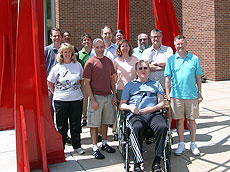Michigan State University

Michigan State University Experimental High Energy Physics Group: Front row from left: Brenda Wenzlick, Tom Rockwell, Kirsten Tollefson, Maris Abolins, Chip Brock and Bernard Pope. Second row from left: Reinhard Schwienhorst, Mike Nila, Philippe Laurens, Wade Fisher, Dan Edmunds and Jim Linnemann. Not pictured: Joey Huston, Carl Bromberg, Jim Kraus, Reiner Hauser, Yuri Ermoline, Pat Ryan, Sarah Heim, Alessandro di Mattia, Weigang Geng, Ron Richards, James Koll, Joel Piper, Jenny Holzbauer, Brian Martin and Patrick True.
NAME:
Michigan State University
HOME TOWN:
East Lansing, MI
MASCOT:
Sparty (Three time national champion mascot, voted "Buffest Mascot" by Muscle and Fitness Magazine.)
SCHOOL COLORS:
Green (Pantone 341, to be exact) and white
PARTICLE PHYSICS COLLABORATIONS:
DZero, CDF, NOvA, ArgoNeut, ATLAS, Milagro/HAWC, E743, E629, E706, E594, E703, CTEQ and R110
EXPERIMENTS AT FERMILAB:
DZero, CDF, NOvA, ArgoNeuT, E743, E629, E706, E594, E703, E663, E585, E383, E743, E629, E382, E366, E319, E311, E281 and E12.
SCIENTISTS AND STUDENTS AT FERMILAB:
Eight faculty, seven students, one postdoc and three engineers and computing professionals
COLLABORATING AT FERMILAB SINCE:
Fermilab opened.
MAJOR CONTRIBUTIONS TO FERMILAB EXPERIMENTS:
For more than 30 years, the MSU Group has specialized in Level 1, Level 2 and Level 3 trigger electronics and software; calorimetry; large-scale scintillator/phototube production; and software design for Fermilab's neutrino, DZero and CDF projects. In addition, all faculty members have been leaders, spokespersons and conveners in technical and physics groups for all of their Fermilab experiments.
PARTICLE PHYSICS RESEARCH FOCUS:
W-mass determination, top quark pair physics, single-top physics, QCD jet physics, searches for new phenomena, Higgs Boson searches, photon/di-photon production, W+jets physics, underlying-event studies, neutrino oscillations, multiple phenomenology collaborations and statistical analyses.
WHAT SETS PARTICLE PHYSICS AT MICHIGAN STATE UNIVERSITY APART?
Excellent technical staff and support, outstanding collaboration between HEP experimenters and theorists (CTEQ home), a congenial and cooperative atmosphere within the HEP group and three decades of terrific support from the department and the university.
FUNDING AGENCY:
National Science Foundation
FAVORITE NATIONAL LABORATORY:
Fermilab
View all University profiles
|